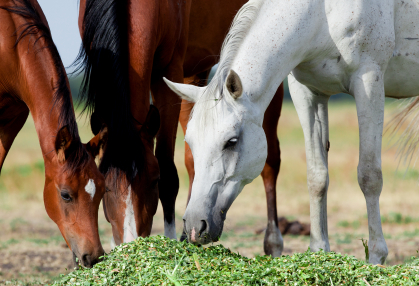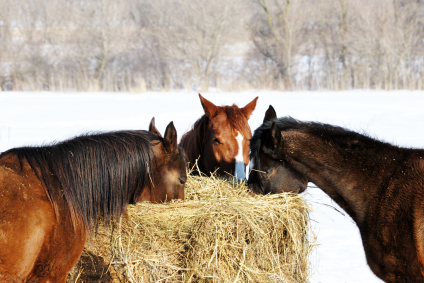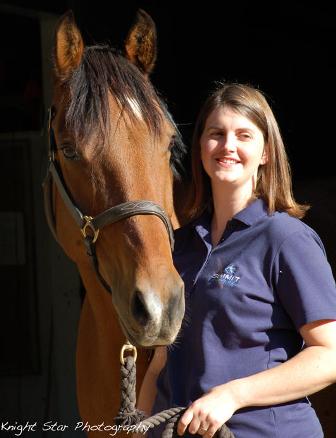 Regardless of the horse, forage should be the foundation of their ration. Even those with the best pastures will find that at some point in the year they will likely need to substitute another form of forage and the most common form of pasture replacement is hay. With forage as the foundation, all other components of the diet should build on the forage adding what may be lacking and improving the overall balance of certain nutrients. While forages can be assessed visually, the only way to accurately know the nutrient content of your forage is to have it tested by a lab.
Regardless of the horse, forage should be the foundation of their ration. Even those with the best pastures will find that at some point in the year they will likely need to substitute another form of forage and the most common form of pasture replacement is hay. With forage as the foundation, all other components of the diet should build on the forage adding what may be lacking and improving the overall balance of certain nutrients. While forages can be assessed visually, the only way to accurately know the nutrient content of your forage is to have it tested by a lab.
Hay testing is easier and cheaper to do than many people realize and is worth considering if you buy large quantities of forage at a time. In fact if the hay is analyzed before purchase and you know how to decipher the analysis you can determine whether that hay is an appropriate investment. Here I’m going to share with you how to take a good sample for analysis and what some of the analysis results are that you can use to decide whether a certain batch of hay is right for your horse’s needs.
Taking a Sample
 The first step when analyzing any forage is to take a representative sample. As the most common pasture substitute is hay, we will focus here on achieving a good hay sample however it is possible to have all forms of forage analyzed. Getting a representative sample means taking hay from at least 15-20 bales which is why it may not be worth doing if you only buy small quantities of hay at a time. Certainly getting any amount analyzed will give you some general information that can be useful but the results from small samples will be less accurate. Every batch of hay is different even when it comes from the same fields so ideally every batch should be tested to account for variation.
The first step when analyzing any forage is to take a representative sample. As the most common pasture substitute is hay, we will focus here on achieving a good hay sample however it is possible to have all forms of forage analyzed. Getting a representative sample means taking hay from at least 15-20 bales which is why it may not be worth doing if you only buy small quantities of hay at a time. Certainly getting any amount analyzed will give you some general information that can be useful but the results from small samples will be less accurate. Every batch of hay is different even when it comes from the same fields so ideally every batch should be tested to account for variation.
While grabbing a handful from the centerof multiple bales is okay, to take a truly representative sample a hay probe is needed. These can be purchased online and one of the easiest to use is the Penn State Corer, which can be attached to an electric drill. Equi-analytical the lab I recommend for analysis sells these probes for $120 and this includes a free Equi-tech analysis (value $28). A probe can also be made from a sharpened golf club (chop off the club end) however if making your own probe make sure that the metal does not contain copper or iron as these will contaminate your sample. Insert the probe 12-18 inches into the bale from the middle of the short end so that you are taking a cross section of multiple flakes. Empty the probe contents from multiple bales into a Ziplock bag, mix in the bag and mail to the lab using their sample information sheet.

Deciphering the Analysis Results
A variety of analyses are possible but some of the easiest things to look at to assess quality are the relative feed value (RFV), digestible energy content (DE), neutral detergent fiber (NDF) and acid detergent fiber (ADF) content, water soluble carbohydrates (WSC), starch and crude protein (CP).
Relative Feed Value
Relative feed value is a method of measuring hay quality that takes into account the expected consumption and digestibility of the hay as a factor of its maturity. The system was designed for use in ruminants however it still has use for assessing hay for horses. As the RFV increases over 100 quality increases and an RFV below 100 indicates lower quality. Comparing RFV’s of different hays is an easy way to quickly assess which is of higher quality.
Digestible Energy
Digestible energy (DE) for horses is not calculated by every lab so ensure that you send your sample to a lab that performs equine-appropriate analysis. The DE per pound will indicate how many calories per pound your horse will receive. Performance horses, brood mares and youngstock will benefit from hays with higher DE values (more than 0.9 Mcal/lb) versus the easy keepers who may benefit from a lower DE (less than 0.9Mcal/lb). By feeding easy keepers lower calorie hay you will be able to keep more hay in front of them which is good for reducing boredom and for their gastrointestinal health.
Carbohydrates
Carbohydrates come in many forms some of which are structural and found in plant cell walls and others which are non-structural and found inside the cells. Structural carbohydrates help give the plant strength as it grows and are more complex in nature. As a result they cannot be digested by enzymes in the horse’s small intestine, and instead require microbial fermentation in the hindgut. Conversely non-structural carbohydrates (NSC) include starch and sugars that for the most part are broken down via enzymes and absorbed in the small intestine.
Non-Structural Carbohydrates
 Starch and simple sugars enter the blood stream resulting in an increase in blood glucose and in turn insulin. For horses that are sensitive to readily available carbohydrates such as horses with polysaccharide storage myopathy (PSSM) or that suffer from an insensitivity to insulin (often referred to as insulin resistance), a history of laminitis, or have equine metabolic syndrome minimizing changes in blood glucose levels through the regulation of NSC intake is a vital component of successful management. Therefore knowing the NSC level of the forages you are feeding such horses is important.
Starch and simple sugars enter the blood stream resulting in an increase in blood glucose and in turn insulin. For horses that are sensitive to readily available carbohydrates such as horses with polysaccharide storage myopathy (PSSM) or that suffer from an insensitivity to insulin (often referred to as insulin resistance), a history of laminitis, or have equine metabolic syndrome minimizing changes in blood glucose levels through the regulation of NSC intake is a vital component of successful management. Therefore knowing the NSC level of the forages you are feeding such horses is important.
Generally it is advised that these individuals should be consuming forages with an NSC of no more than 12% on a dry matter basis. When you look at the analysis results you receive from the lab you will often see two columns of numbers one labeled “as-is” or “as-fed” and the other labeled as “dry matter”. All feeds in the form that they are in when fed contain some level of moisture (represented by the as-fed values) and while this is what the horse is eating it makes comparison between feeds difficult so nutritionists compare feeds on a dry matter basis, without the water fraction.
Your forage analysis may not give you a value for NSC but if they provide you with values for percent starch and WSC (water soluble carbohydrates) you can calculate NSC by adding the two together. Water soluble carbohydrates are exactly as the name suggest, soluble in water. This means that if your hay provides more than 12% NSC and you are feeding a sensitive horse you can somewhat lower the level by soaking the hay in water before feeding it. Soaking for 30 minutes is generally enough to lower the WSC without leaching out other desirable nutrients however the amount of WSC removed varies. To be sure soaking has removed enough of the WSC fraction to make it safe to feed, a soaked sample should be tested by the lab.
You may also have heard of ether soluble carbohydrates (ESC). These are the simple sugars that along with starch enter the blood stream from the small intestine, they are a component of the WSC although do not comprise the entire WSC fraction. Because the ESC and starch fraction directly impact blood glucose levels some experts pay more attention to their levels in forage than the amount of WSC and starch recommending that the ESC plus starch should be 10% or less for sensitive horses.
 The difference between the WSC and ESC fractions can be used as an estimate of the fructan content. Fructans are sugars but due to their complex structure they are not digested by enzymes in the small intestine instead going through microbial fermentation in the hindgut. This process is similar to the fermentation of the structural carbohydrates however fructans are very easy to ferment which can cause problems such as gas production and changes in the hindgut environment for some horses. While fructans in cool season pasture grass are of greatest concern in sensitive horses (especially those with a history of pasture laminitis), it is still advisable to choose hay with low NSC for these horses.
The difference between the WSC and ESC fractions can be used as an estimate of the fructan content. Fructans are sugars but due to their complex structure they are not digested by enzymes in the small intestine instead going through microbial fermentation in the hindgut. This process is similar to the fermentation of the structural carbohydrates however fructans are very easy to ferment which can cause problems such as gas production and changes in the hindgut environment for some horses. While fructans in cool season pasture grass are of greatest concern in sensitive horses (especially those with a history of pasture laminitis), it is still advisable to choose hay with low NSC for these horses.
Structural Carbohydrates
Neutral and acid detergent fiber values are measures of structural carbohydrate and therefore their levels increase as the plant matures making them an indicator of the hays maturity at cutting. Neutral detergent fiber a measure of the plants cell wall content increases as the plant matures and is an indicator of how palatable the hay will be. As the plant matures the proportion of cellulose plus lignin (ADF) increase and the plant becomes less digestible. NDF levels below 40% are excellent and over 65% are unlikely to be eaten. ADF values over 45% have little nutritive value and below 31% are excellent. Horses working hard, broodmares and youngstock will benefit from hay with excellent NDF and ADF values and easy keepers will be able to consume more hay if it has slightly higher NDF and ADF content.
Crude Protein
Crude protein (CP) in the hay is a crude estimate of the actual protein content. Legumes typically have high crude protein contents (18.5-23.5%) while grass hays have moderate levels (7-15%) with grain hays generally having the lowest (5.5-11%). Level of maturity at cutting impacts protein content with more mature hays having lower crude protein. If a large enough amount of low protein hay is fed it is still possible to meet a horse’s protein needs.. Alternatively when feeding a lower protein grass or grain hay a legume hay may be added to the ration to increase the overall protein level.
Young growing horses have the greatest need for protein in their ration, again making them candidates for the higher quality less mature cuttings. While it is possible to meet most horse’s crude protein needs even when feeding a lower protein hay, the quality of that protein may not be adequate to meet all of their requirements and it may be necessary in those situations to feed a source of good quality protein such as those found in many commercial ration balancing feeds.

Other Analysis
Much more information is also provided on the analysis sheet including the levels of numerous minerals, which can be very beneficial in helping to determine which feeds and supplements will compliment your hay and insure a balanced diet. Knowing what to do with this data can be confusing and working with a qualified equine nutrition professional is advised.
In Conclusion
Forage is so much more than just bulk—it makes up the majority of your horse’s ration and is therefore a major source of nutrition it probably one of your biggest ticket purchases each year. While it can seem unreasonably expensive, making informed decisions and paying for good quality forage will save you money in other areas. Analyzing hay can help you make good purchase decisions and once purchased will help you make appropriate additional feed and supplement choices.
______________________________________________________________________________________________
 Dr. Clair Thunes independent equine nutritionist and owner of Summit Equine Nutrition LLC
works to take the guess work out of feeding horses and providing her
clients with the peace of mind that their horses have exactly what they
need. Clair has experience formulating balanced nutrition programs for
breeding farms and performance stallions. Her Strong StartTM program provides correct nutrition for the foal from conception through to 1st birthday and further details may be found here. Contact Clair at clair@summit-equine.com or 916-248-8987 to learn more about how her programs can benefit your farm.
Dr. Clair Thunes independent equine nutritionist and owner of Summit Equine Nutrition LLC
works to take the guess work out of feeding horses and providing her
clients with the peace of mind that their horses have exactly what they
need. Clair has experience formulating balanced nutrition programs for
breeding farms and performance stallions. Her Strong StartTM program provides correct nutrition for the foal from conception through to 1st birthday and further details may be found here. Contact Clair at clair@summit-equine.com or 916-248-8987 to learn more about how her programs can benefit your farm.
Photo credit for photos of hay testing procedure - Padma Video.


Log in to join the conversation.